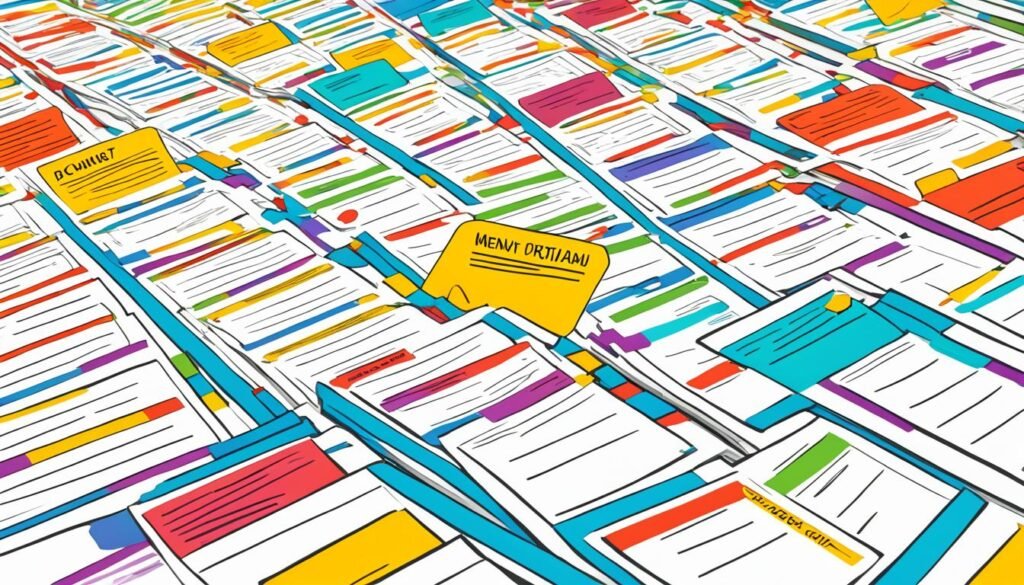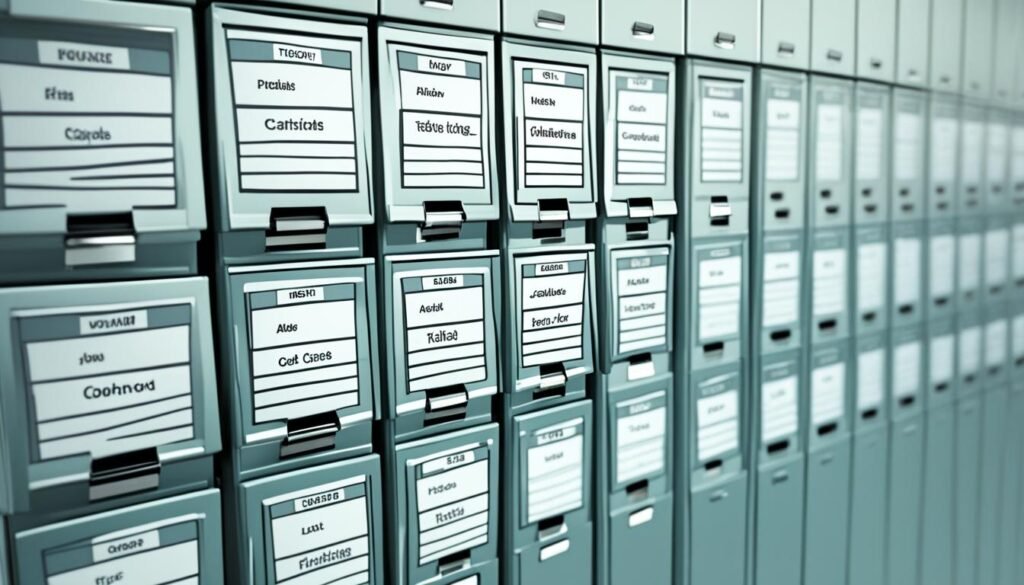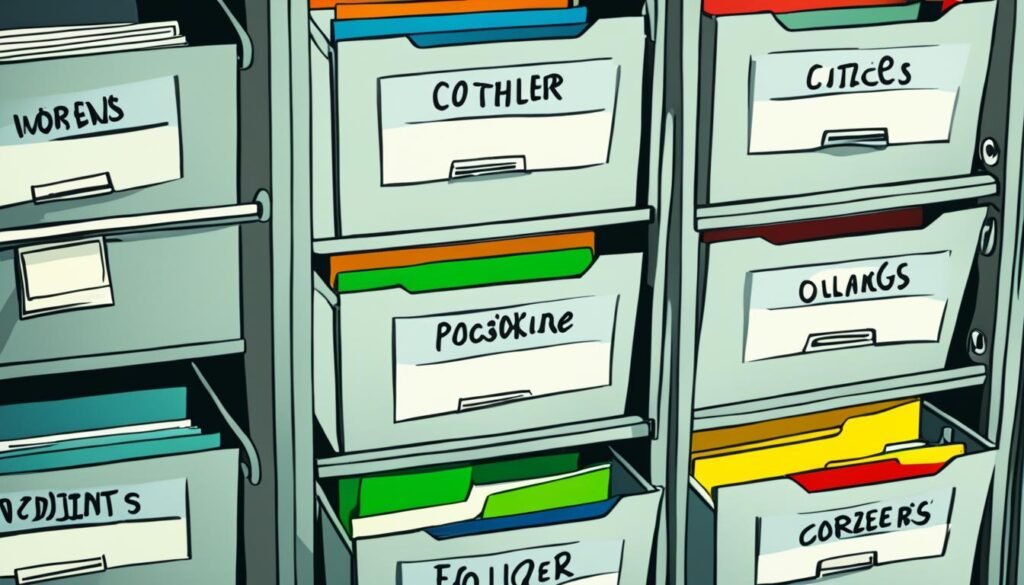“For every minute spent organizing, an hour is earned,” said Benjamin Franklin. Embracing his advice, mastering filing system organization is key for productivity. It lets us use time better. With so many documents, paperwork, papers, and folders in your space this year, you need an effective document management solution.
Organized filing methods are crucial in every industry. They help keep paperwork running smoothly by organizing, storing, and protecting documents efficiently. Whether you’re new or looking to improve your skills, learning the basics boosts your productivity and keeps your important documents safe.
Setting up a good filing strategy is easier than it seems. Choose a system that matches your document types and how often you’ll access them1. Using clear categories and a searchable index does more than organize—it secures and improves your business1.
Key Takeaways
-
Pick a system that fits your document types and access needs for easier management1.
-
Use clear naming for all files to make searching simple and keep errors low1.
-
By updating and categorizing files regularly, they stay recent and easy to find1.
-
Security steps keep important information safe, strengthening your document management1.
-
Reviewing your filing system often helps it stay helpful and adaptable.
-
Adding colors to different categories can make filing and finding things faster2.
-
Remember, the most crucial documents are just a small part of all your files. Focus on them for a better system3.
A dependable organized filing method turns your busy work life into something efficient and straightforward2. If you haven’t started setting up an effective system yet, now’s the time. The benefits are huge—clearer thinking, peace of mind, and more control over your schedule. Learn more about how a great filing system can make your work better with expert advice3.
Understanding Different Filing Method Options

Organizing your documents starts with picking the best efficient filing system. Whether it’s alphabetic customer records, sequential documents like invoices, or a mix for different media, the right choice improves space and access.
Older filing methods fall short compared to modern ones that boost office performance and space. High-density mobile shelving, for example, can increase space usage by up to 339% over traditional shelving4.
Color-coded labels help find information 40% faster than usual systems4. Whether you choose alphanumeric filing systems, numeric, or terminal digit depends on the document volume and type. Alpha systems suit up to 2,500 folders, perfect for small businesses. Numeric and Terminal digit systems fit 10,000 to over 100,000 folders, ideal for larger needs4.
| Filing System Type | Capacity (Folders) | Ideal Use Case |
|---|---|---|
| Alphabetic | 1,000-2,500 | Personal or Small Business |
| Alpha Numeric | 1,500-20,000 | Medium Enterprises |
| Numeric | 10,000-80,000 | Large Corporations |
| Terminal Digit | 40,000-100,000+ | Healthcare and Financial Institutions |
Why change your filing system? A good system can save up to an 82% more space than old ones4. It not just saves space. It also cuts down on search times, boosts productivity, and eases office stress.
Looking for paper organization tips? Using document management software is key, especially as data grows by about 19.7% each year5. This tech helps manage all files better, cutting down the time spent on finding documents, which can be up to 30% of a workday5.
Mastering Labeling and Indexing Best Practices

Finding what you need quickly is key in document management. Good labeling and indexing strategies make your filing system efficient.
Develop Clear and Concise Labeling Strategies
Alpha labels are common in law offices and hospitals. They help organize files easily, especially when documents grow quickly6. Adding colors to alpha labels speeds up finding files. Each color stands for a letter or group, making it faster to spot what you need6. It’s important for everyone to use the same labeling rules. This way, files can be found quickly and without mistakes6.
Learn better labeling by checking this guide on alpha labels for folders.
Construct an Accessible and Maintainable Index System
An index keeps your filing system easy to navigate. Keeping it updated is key to its success7. Now, digital tools with AI and blockchain make indexes even better. They improve accuracy and security7. Small steps in updating your index make a big difference in staying organized7.
Improve your indexing with tips from mastering document indexing.
Utilize Software Tools for Enhanced File Identification
Software tools can change the game for file organization, especially moving from paper to digital8. Programs like Evernote, Google Docs, and Adobe Creative Cloud support different file types. They make managing files easy8. Cloud services like Google Drive and Dropbox offer secure, big storage spaces8.

Adopting these methods will make your filing process smoother. It will keep your system easy to use, efficient, and modern. By focusing on good labeling, keeping an accurate index, and using the latest digital tools, your business’s organization will be top-notch for the future.
Storing and Securing Your Documents Effectively
It’s key to have a secure filing system and a complete document management solution for the safety of your organization’s info. In today’s world, we need ways to work fast yet keep our data safe from unwelcome eyes and data leaks.
Organizing your business files well is vital for top productivity and quick access to important papers9. A tidy file system cuts down on wasted time and makes work flow smoother9. So, it’s important to use the latest in locks, encryption, and systems that control who can get in.
Check out ways to boost work efficiency by sorting your files right, per advice given at maximizing productivity through file organization9. Doing this ensures you won’t lose important docs, which could cost you money, legal headaches, or harm your company’s name9.
Using tools like Dropbox, iCloud Drive, OneDrive, Box, and Google Dominant, noted in Asian Efficiency’s guide, can up your file handling and sharing game10. These services help teams work together better, keeping files safe in the cloud.
| Filing System Type | Key Benefits |
|---|---|
| Alphabetic | Simple to use, though mixing up or confusing similarly named files can happen11. |
| Numeric | Makes finding files fast and keeps things accurate, perfect for keeping confidential info in finance and health fields11. |
| Color-coded | Makes it easier to move through and sort your files visually11. |
Investing in real-world storage like shelves or cabinets is smart too, as Southwest Solutions points out11. With good storage and smart naming, you’ll find documents easier down the line10.
Using these tips, you can keep your docs safe and your document management solution solid against dangers. This way, you protect sensitive info and help your team focus better, lowering stress9.
Periodic Sorting and Purging: Keeping Your Filing System Lean
To keep your workspace neat, it’s crucial to clean up your files regularly. Too many documents can slow you down and make it hard to stay organized. By sorting and throwing away files periodically, you make things run smoother and help the environment too.

Start by setting up rules for keeping or tossing documents. Sort papers by how often you use them, just like some businesses do. Know the legal rules for how long to keep files. This keeps your filing cabinet tidy and ready to use. You can manage important papers like tax documents without crowding your main filing area12.
Implement Retention and Disposal Policies
Create clear rules for what to keep and what to throw away. Archiving paperwork yearly, usually in January, helps avoid clutter13. Using a system where files are reviewed yearly also helps reduce pile-up13.
Regular Reviews to Eliminate Redundancy
Schedule checks of your filing system to remove unneeded papers. Spending about two hours reviewing one and a half drawers can keep things organized14. This step keeps your workspace clean and makes managing documents easier14.
Getting to a clutter-free and paperless filing system takes some work at first. But the effort pays off with a smoother workflow and a nicer place to work. It lowers stress and boosts productivity by making it easier to find what you need.
Adhering to Filing System Rules and Standards
Filing system rules are super important in keeping an office organized. By following these rules closely, we make sure our documents are easy to find and safe. This keeps everything running smoothly.

Choosing the right tools for filing is key. Using strong, roomy folders like Pendaflex Extra Capacity Reinforced Hanging File Folders helps keep files in order15. Also, using different colored folders can make finding things faster. For instance, blue for health or HR, green for finance, and red for employee stuff15.
For keeping files on computers, systems like SharePoint are great16. They can handle lots of data and help team members work together better. They also keep things safe with backups. It’s important to organize everything well, so only the right people can see sensitive documents16.
Computerized filing doesn’t just save time; it also makes documents safer17. It protects against data loss and makes sharing files easy. Plus, using digital signatures can help finish deals faster by making approvals quicker17.
Following these filing methods makes an office work better. It creates a reliable and accountable way of dealing with documents. It’s vital that everyone in the team knows and uses these methods. This is key to doing well as an organization.
Filing System Organization: Tailoring the System to User Needs
Creating a system for keeping files in order is key for any business. But it must be set up based on what its users need to really work well. We will look at how things like how often people need to get to files, the way a company is set up, and getting feedback play a big part in making a system focused on the user for managing documents.
Consider the Filing varying users and Access Frequency
Think about how often each department needs to get certain documents. For areas that need files often, a system that’s easy to use and get to helps their day-to-day tasks18. Yet, files that aren’t needed much but need to be kept, like old tax records or employee histories, can go in storage that’s not used often19.
Organize Documents by their department and functionality
Setting up your file system to mirror your company’s structure can make finding files much simpler18. For example, having different sections for Human Resources, Finance, and Operations makes the system neater and more effective18.
Feedback for regular improvement
Getting and using feedback from those who use the system is vital. It helps make the system better and can be adjusted as needed, making the workplace better and more productive18. Regularly talking and getting opinions can show how well the file system works and what changes might be needed.

| Feature | Benefit |
|---|---|
| Customizable Categories | Helps with better file keeping and finding files quicker18 |
| User Feedback Integration | Makes sure the system stays up-to-date with what users and the business need18 |
| Access Based on Frequency | Cuts down the time needed to find files that are used often18 |
By looking into these areas, your filing system can meet what your organization needs now and be ready for future changes. This makes it a system truly based on what users need and an efficient way to keep files.
Conclusion
An efficient filing system is key to a smooth-running office. Moving to a paperless system helps clear out clutter and makes files easier to find20. Digital filing systems improve workflow. They keep files organized and quick to locate2021.
A messy filing system wastes about six hours every week22. Keeping your files tidy through smart organization and regular clean-ups saves time. It also keeps your business’s good name2221.
Choosing the right filing system for your business is crucial21. It should fit your company’s pace and style. Regular checks and updates will keep it working well. It’s about making a system that grows and adapts with your business.
FAQ
What are some effective strategies for creating and maintaining a filing system?
For an effective filing system, pick a method that fits your documents and how often you need them. Use clear labels and keep an index up-to-date. Make sure your files are safe, and check the system regularly to keep it working right.
What are the different filing methods I can use?
You can organize files in many ways, like by letters, numbers, dates, or categories. Pick the method that fits your files best, whether they’re for clients, sorted by date, or by topic.
How can I develop a clear and concise labeling strategy for my files?
Make your labels straightforward and related to what’s inside, using names, dates, or topics. Make sure every file label looks the same. This could mean the same order of info, using short forms, or color codes for easy spotting.
What is an index system and how do I maintain it?
An index system points you to your files. Keep it updated with any changes to your files. Make sure it’s easy to use and consider a digital index for simpler searches and updates.
What tools can help with file identification in my digital filing system?
Look for document management software that has good search, tagging, and metadata tools. These can help you find files faster and keep things organized.
How can I ensure that my documents are stored and secured effectively?
For paper files, use locked cabinets. For digital, go for encrypted folders with strong passwords. Don’t forget to back up your files and use access controls so only the right people can get to them.
What should my retention and disposal policies include?
Your policies should say how long to keep different document types based on laws and your business needs. Also, detail how to trash documents securely when you don’t need them anymore.
Why is it important to conduct regular file system reviews?
Checking your files regularly gets rid of old or unnecessary ones. This makes your filing system tidier and better. It also keeps it up-to-date with any business or legal changes.
How should I adhere to filing system rules and standards?
Learn and stick to your organization’s filing rules. This might include how to name documents, handle them, and keep them private. Doing so keeps everything consistent and professional.
How can I tailor the filing system to meet user needs?
Think about how people use the system and what they need from it. You might reorganize files or always ask for feedback to improve how the system works for everyone.
What are the benefits of organizing documents by department and functionality?
Keeping files by department helps with workflow, as team members can find what they need faster. It helps the whole office run smoother by making work processes and talking between departments easier.
How can incorporating feedback improve a filing system?
Getting input from people who use the filing system helps you make it better. It lets you solve problems, meet new needs, and keep the system useful for everyone.
